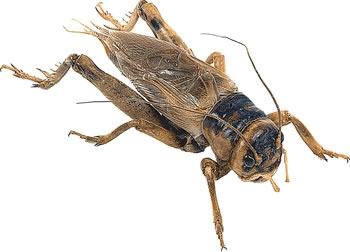
Description: The adult House Cricket is about two centimeters in length and are varying shades of brown with black markings about the head and thorax. The female is told from the male by the presence of an ovipositor, a long extension attached to the end of the abdomen, used for depositing eggs in the soil. House crickets have conspicuous jumping legs and have two pairs on wings, of which, only the back pair are used for flight.
Range: House crickets are found throughout much of the world. In North America, they are generally confined to areas east of the Great Plains.
Habitat: House Crickets can be found in a variety of habitats including woodlands, suburbs, urban areas, buildings, ducts, siding, restaurants and anywhere else there happens to be a food supply and warm air. Although many crickets die off in the colder months, those that manage to find their way indoors can stay alive year round.
Reproduction: Crickets reach sexual maturity between eight and twelve weeks after birth. Males attract mates by rubbing their wings together to produce a noise sometimes referred to as "chirping". Technically, this process is called stirdulation. Interestingly enough, the rate in which a cricket "chirps" is determined by the temperature outside. When it is warmer, crickets chirp faster. Scientists can actually tell the exact outdoor temperature by timing the rate of cricket "chirpings". After the male mates with female, the female will lay between 50 and 100 eggs in the ground or another soft surface. The eggs hatch in about two weeks.
Life Cycle: Incomplete Metamorphosis: egg -> nymph -> adult
Diet: House Crickets will eat just about anything including soft plant matter, insects, young crickets, and decomposing matter.
|